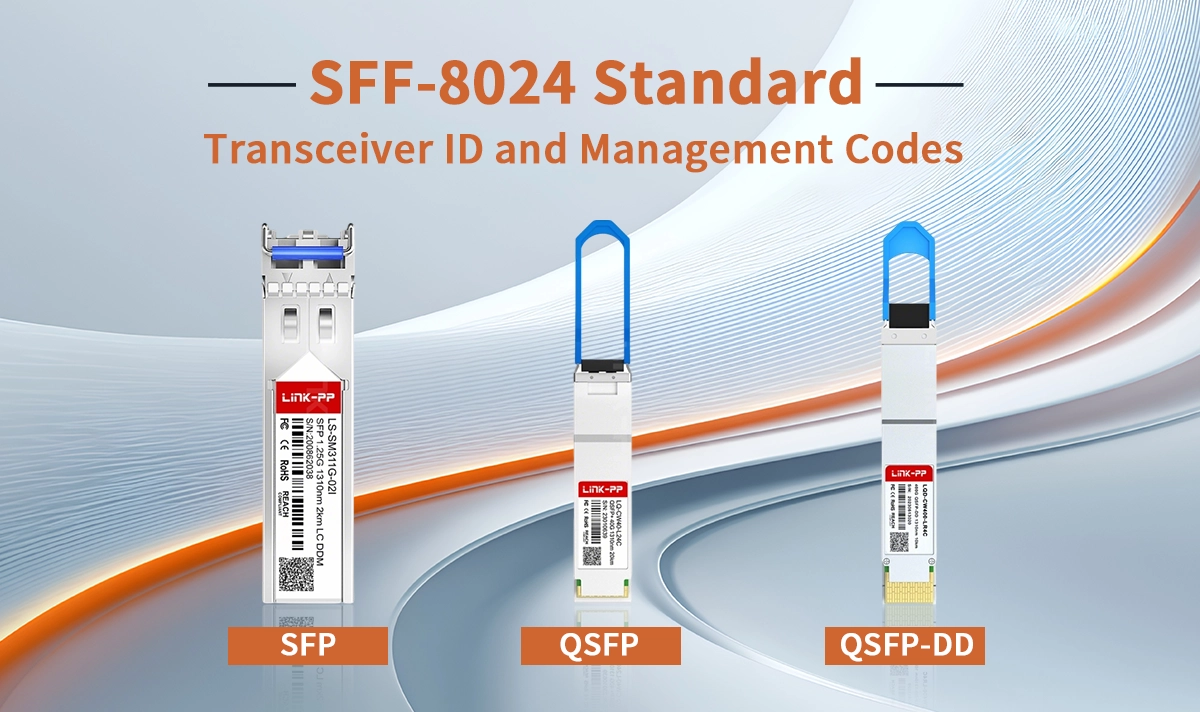
✅ Introduction
In the world of optical networking, seamless interoperability between host systems and pluggable transceivers is essential. The SFF-8024 standard, maintained by the Small Form Factor (SFF) Committee, provides a unified framework of Transceiver ID and Management Codes. These codes allow host devices to correctly identify, configure, and manage a wide range of pluggable modules—including SFP, SFP+, QSFP, OSFP, and SFP-DD—ensuring consistency across vendors and technologies.
✅ What is SFF-8024?
SFF-8024 defines a comprehensive registry of identifiers and codes stored in a transceiver’s EEPROM. When a module is inserted into a switch, router, or network appliance, the host reads these identifiers to determine the module’s form factor, management interface, electrical signaling, optical media support, and encoding protocols.
Key examples of Identifier Codes include:
03h→ SFP, SFP+, or SFP28 module0Dh→ QSFP+ with SFF-8436/SFF-8636 management interface1Ah→ SFP-DD (Dual-Density SFP)18h,19h→ OSFP and other emerging high-density modules
This standard provides the foundation for interoperability across generations of transceivers and networking platforms.
✅ Core Components of SFF-8024
Identifier Values
Define the physical form factor of the module (SFP, QSFP, OSFP, etc.).Encoding & Protocol Support
Specifies signaling methods such as NRZ or PAM4, enabling accurate host-to-module compatibility.Connector Types
Covers a wide range of physical interfaces, including LC duplex, MPO/MTP, and UPC connectors.Host Electrical Interface Codes
Indicates electrical lane speeds and technologies (10GBASE-SR, 25GBASE-LR, 100GBASE-LR4, etc.).Media Interface Codes
Identifies supported optical media (multimode fiber, single-mode fiber) or copper cabling.
✅ Recent Updates and Evolution
The SFF-8024 specification is continuously updated to align with the rapid evolution of optical networking.
Rev 4.13 (July 2025): Introduced codes for QSFP-DD800, OSFP-XD-RHS, and Linear Pluggable Optics (LPO-MSA).
Earlier revisions: Added support for OpenZR+, CMIS (Common Management Interface Specification), OpenROADM, Terabit BiDi, and 200G per lane signaling.
These updates ensure the standard remains relevant for next-generation transceivers used in 400G, 800G, and beyond data center networks.
✅ Why SFF-8024 Matters
Application Scenario | Role of SFF-8024 |
|---|---|
Module Identification | Ensures the host can correctly detect module type and capabilities |
Multi-Vendor Interoperability | Standardized codes improve cross-vendor compatibility |
Network Automation | Enables management systems to retrieve module attributes programmatically |
Technology Expansion | Provides a framework for adopting emerging optics such as PAM4, CMIS, and LPO |
For instance, when a switch reads
03has the identifier, it immediately recognizes the device as an SFP+ module. Similarly, a value of1Ehindicates a QSFP module using the CMIS management interface.
✅ Conclusion
The SFF-8024 standard serves as the backbone of optical transceiver identification and management. By defining a universal set of IDs and codes, it guarantees accurate recognition, smooth integration, and future-proof scalability across diverse networking environments. As data rates continue to accelerate toward terabit-class systems, SFF-8024 remains indispensable in ensuring that optical modules and host systems communicate seamlessly.




